Introduction - Chapter 1 Historical Background And The Fingerprints Of Relevance
The historical background in brief
1.1. In January 1997, Miss Marion Margaret Campbell Ross was found dead in her home in Kilmarnock, Scotland. The murder investigation team included, for a few days, a detective constable, Ms Shirley McKie, then known as DC Cardwell.
1.2. Scene of crime examinations carried out in the course of the investigation into Miss Ross's murder yielded 428 fingerprints and these were examined by the fingerprint bureau of the Scottish Criminal Record Office (SCRO) in Glasgow.
1.3. SCRO identified one of the fingermarks in Miss Ross's house, Y7, as having been made by Ms McKie. A mark on a gift tag in the house, XF, was identified as having been made by Mr David Asbury. Part of a mark on a tin of money in his home, QI2, was identified as having been made by Miss Ross.
1.4. Mr Asbury was prosecuted for the murder of Miss Ross, and convicted in June 1997, with fingerprint evidence being part of the prosecution case.1
1.5. During Mr Asbury's trial, although there were disputes about the provenance of certain fingerprints with suggestions of planting being made, no issue arose with any of the identifications made by SCRO. Ms McKie was one of the many witnesses and she gave evidence about her involvement in the murder investigation. She was asked about the fingerprint attributed to her. She did not accept that it was hers, as she denied being in the house beyond the porch.2
1.6. Following the murder trial, Ms McKie was prosecuted for the crime of perjury on the basis that she had lied while giving evidence on oath. At her trial in 1999, American fingerprint experts, Mr Pat Wertheim and Mr David Grieve, disputed the identification of Y7. The jury unanimously found Ms McKie not guilty.
1.7. The case had attracted media attention. After her acquittal Ms McKie's father, Mr Iain McKie, raised in correspondence with the Scottish authorities a number of issues concerning the prosecution of his daughter and the expertise and conduct of those on whose fingerprint evidence the prosecution relied. In the years that followed he conducted a campaign through the media, members of Parliament and others to address what he saw as failings in the justice system that were not being addressed and the case featured globally on the internet.
1.8. In early 2000, the case was given added publicity in two television programmes. In these, doubt was cast not only on the identification of Y7 as having been made by Ms McKie, but also on the identification of QI2 as having been made in part by Miss Ross.
1.9. Over the following months various enquiries were carried out by the police and other public authorities. Experts from Holland, Norway and Denmark were involved and their work resulted in doubts being raised about other marks connected with the two cases.
1.10. The first of these enquiries was by Her Majesty's Chief Inspector of Constabulary for Scotland (HMCICS), William Taylor, who carried out an inspection of the SCRO fingerprint bureau. His emerging findings were made public in June 2000 and the then Minister for Justice, Jim Wallace,3 informed the Scottish Parliament that Ms McKie's fingerprint had been misidentified and that the bureau was not fully effective and efficient.4
1.11. The Association of Chief Police Officers in Scotland (ACPOS) established two review teams. One was a Change Management Review Team and the other, led by the then Deputy Chief Constable of Tayside Police, James Mackay, was a detailed investigation of the circumstances surrounding the fingerprint identification. The Lord Advocate, Colin Boyd Q.C.,5 appointed the then Regional Procurator Fiscal for North Strathclyde, William Gilchrist,6 to inquire into allegations by Mr McKie of criminal conduct on the part of fingerprint officers in SCRO. Four SCRO fingerprint officers were suspended on a precautionary basis, and two were moved to non-operational duties.
1.12. In August 2000 a meeting of experts to discuss the identification of Y7 was held at Tulliallan, the Scottish Police College. Mr Taylor's report on the SCRO fingerprint bureau was published in September7 and Her Majesty's Inspectorate of Constabulary (HMICS) also inspected the entire SCRO. The Mackay report was submitted to Mr Gilchrist and the Change Management Review Team published its report.8 The Court of Criminal Appeal released Mr Asbury from prison pending the hearing of an appeal against his conviction. The Crown did not oppose the application.
1.13. All SCRO identifications over 13 months from June 2000 were independently checked. Historical cases involving the four officers who had been suspended were also examined. No errors were found.
1.14. In 2001, HMICS published its report on the Scottish Criminal Record Office, considering it to be efficient and effective taken as a whole.9 The Scottish Fingerprint Service (SFS) was established as a centrally managed organisation operating from four locations, Aberdeen, Dundee, Edinburgh and Glasgow. Mr Gilchrist reported to the Lord Advocate. Neither the Mackay nor the Gilchrist reports were published. The Lord Advocate intimated that no criminal proceedings were to be taken against the fingerprint officers.
1.15. Ms McKie began civil proceedings against the Chief Constable of Strathclyde Police (on the manner of her arrest) and against SCRO and its officers. Strathclyde Joint Police Board, the employers of the fingerprint officers, appointed an 'independent investigating officer', Mr James Black, to investigate whether there were grounds for disciplinary action on the basis of conduct or capability and report to a scrutiny committee.
1.16. In 2002, the Court of Session dismissed Ms McKie's action against Strathclyde Police.10 The Black report concluded that no matters of misconduct or lack of capability had taken place in the work surrounding Y7 and QI2, and the scrutiny committee recommended that the Board reinstate the four suspended SCRO officers and return the other two to operational duties.11 The Crown did not oppose Mr Asbury's appeal and his conviction was quashed. Calls began to be made for a public inquiry.
1.17. In 2003, Ms McKie's appeal against the dismissal of her civil claim against Strathclyde Police was dismissed.12 Her claim for compensation was now against Scottish Ministers as vicariously liable for any wrongs committed by officials of SCRO. When the action was commenced she alleged (in short) that the SCRO examiners had "negligently, or recklessly, or deliberately" stated and maintained an erroneous identification of Y7.13 The Court of Session ruled that there should be a hearing of evidence.14 In 2004, the basis of Ms McKie's claim was narrowed to an allegation that the SCRO examiners had acted maliciously.
1.18. HMICS published in 2005 its Primary Inspection report of 2004 on SCRO.15 In July 2005 the Scottish Ministers announced that they would admit that the SCRO examiners had made a mistake in identifying Y7 as Ms McKie's print and that they would enter into negotiations to settle the civil case.
1.19. In 2006 on the morning of 7 February, the day on which the hearing of evidence was to begin, the case was settled on the basis of a payment of £750,000 to Ms McKie with no admission of liability. The only ruling by the court was as to costs.16 The then First Minister, Jack McConnell, told the Scottish Parliament that the identification of Y7 was an honest mistake, but it became evident that neither Ms McKie and her father, nor the SCRO officers, believed this to be the case.17
1.20. The newspaper 'Scotland on Sunday' published articles in February 2006 based on information from the Mackay report that it had obtained.18 The Justice Minister instructed preparation of a plan for the development of the SFS as an integrated part of a new Scottish Forensic Science Service, which was published as the 'Action Plan for Excellence'. The Scottish Parliament decided, following debate, that action needed to be taken to restore confidence in the SFS but a public inquiry was not appropriate.19 It passed legislation which included provision for the creation of a Scottish Police Services Authority (SPSA).20
1.21. The Scottish Parliament's Justice 1 Committee began a parliamentary inquiry whose purpose was to contribute to the process of restoring public confidence in the SFS. It took evidence from many individuals, including the SCRO fingerprint officers and practitioners who disagreed with them.
1.22. In February 2007 the Justice 1 Committee published its report. It was not part of its remit to give a view on whether Y7 was correctly identified or not but it highlighted the "widely divergent professional opinions" and, more broadly, considered that the SFS faced considerable challenges to become a recognised centre of excellence, recommending that the Action Plan be strengthened in the areas of leadership and management, human resources, procedures and quality assurance.21
1.23. Five of the SCRO fingerprint examiners left SFS employment in March 2007 on agreed terms. One did not agree a settlement and later appealed her dismissal. They continue to maintain that their identifications are correct.
1.24. In April 2007 SCRO and the other bureaux in the SFS became part of the SPSA. On 24 August 2007 the Scottish Government indicated that it would be setting up an Inquiry into the Shirley McKie case,22 and, as noted in the Preface, the establishment of this Inquiry was announced in March 2008.23
The fingerprints of relevance to the Inquiry
Terminology
1.25. In this Report the word 'mark' is normally used for a fingerprint that is found in the course of an investigation, and 'print' for a fingerprint that is taken from a known individual, usually in controlled conditions such as at a police station.
Y7, QI2, QD2, QE2, QL2, XF
1.26. The Inquiry's terms of reference highlighted Y7 but in referring also to "the fingerprints associated with, and leading up to, the case of HM Advocate v McKie" the remit was understood to embrace other marks, and I decided that the following were relevant:
- Y7: a mark on the door-frame of the bathroom where Miss Ross's body was found;
- QI2: a cluster of marks on a tin containing money found in the home of David Asbury parts of which were identified as the marks of Miss Ross and Mr Asbury (and referred to in this report as QI2 Ross and QI2 Asbury, respectively);
- QD2: a mark on a banknote in that tin;
- QE2 and QL2: marks on the tin; and
- XF: a mark on a Christmas gift tag found in the living room of Miss Ross's house.
Why the marks were relevant
1.27. The identifications of Y7, QI2 (Ross), and QD2, as belonging to Ms McKie, Miss Ross and Mr Asbury respectively, had all come to be disputed, and the view had been expressed that QI2 (Asbury), QE2 and QL2, all identified as belonging to Mr Asbury, were of insufficient quality for such determinations.
1.28. XF was included because it had been an important mark in the trial in HMA v Asbury and, though the identification had not been disputed, I wished to confirm that there was no room for doubt. It emerged that questions were raised by Mr Wertheim about the authenticity of the mark.24
Mark not pursued: Z7
1.29. Z7 was a partial palm print. It was found at the same time as Y7 and can be seen in the same images25 immediately below Y7 on the door-frame. SCRO records indicate that it was set aside by Mr Alister Geddes, one of the SCRO fingerprint examiners, as fragmentary and insufficient26 and therefore it was not included in the productions prepared for court. The Inquiry's initial interest in this palm print lay in the possibility that it might have been linked to Y7 and, if so, might assist in ascertaining whether Y7 was made by a left thumb (as SCRO concluded) or another digit. In the event Z7 was not pursued in the comparative exercise or at the hearings in part because it had not featured in the preceding debate and was not raised as an issue by any of the parties to the Inquiry and also because the debate about Y7 among the witnesses turned more on the observed details in the mark than on the question whether it was considered to have the pattern of a thumb print.
1.30. To eliminate any doubt I asked the Metropolitan Police to examine Z7. The Metropolitan Police assigned the task to three fingerprint examiners and reported that Z7 contained insufficient detail for search or comparison purposes and was not associated with Y7.27
The mark Y7
1.31. Y7 was found on a painted wooden frame surrounding the door into the bathroom where Miss Ross's body was found. Viewed from the hall, Y7 was on the right hand side of the entrance to the bathroom. It was about 5 feet28 above ground level on the inside face of the door-frame.29
1.32. The Inquiry obtained copies of two photographs taken in the house with the door-frame in place.30 Figures 1 and 2, prepared for the Inquiry, illustrate the part of the door-frame on which Y7 was found with door open and door closed.31
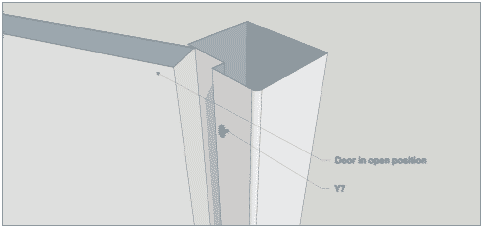
Figure 1
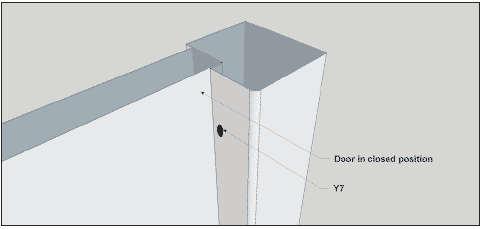
Figure 2
1.33. The mark was measured by Dr Stephen Bleay, of the Home Office Scientific Development Branch (HOSDB), as being at its longest point 16.5mm and its widest 9.5mm32 and is shown, actual size, in figure 3.33
1.34. The door-frame on which Y7 was deposited was seized by the police and removed from the scene but is still available for examination and I was therefore able to view it. Seen in its natural state Y7 was not uniform in appearance. Part of it was more prominent, a darker oval occupying about two-thirds of its area, and the remainder fainter. The contrast is best seen in one of Dr Bleay's photographs in his initial report.34
1.35. In evidence to the Inquiry Mr Geoffrey Grigg of the National Policing Improvement Agency35 drew attention to the unusual outline of the mark on its right side where the bottom of the mark steps out from the line of the upper part as shown in an image in one of Dr Bleay's reports.36 Mr Grigg's explanation that this reflected the contours of a groove in the wood was confirmed by experiments with different light sources carried out by Dr Bleay37 and the groove can be seen in Dr Bleay's images d and e in Figure 4 in Dr Bleay's report.38 The groove had been mentioned by
Mr Arie Zeelenberg and Mr Torger Rudrud, Heads of the National Fingerprint Service in the Netherlands and Norway respectively, in their report for HMCICS dated 28 June 200039 and it was accepted as the explanation for the outline of the mark by Mr Robert Mackenzie, Deputy Head of the SCRO Fingerprint Bureau, in his report of 29 August 2000.40
1.36. The mark has been photographed on at least seven occasions:
- three times by scene of crime officers as part of the murder investigation: on 14 January, 12 and 18 February 1997;
- by Mr Terry Kent of the then Home Office Police Scientific Development Branch (now retired), in March 1997;41
- by Mr Wertheim in 1999;42
- by the National Training Centre at Durham;43 and
- by Dr Bleay in 2009 for the purposes of this Inquiry.44
In the photographs taken after March 1997 there is a striation across the middle of the mark which Dr Bleay suggested may have been caused by string tied around the exhibit to attach a label to it.45
1.37. Ms McKie's prints have been taken on at least six occasions:
- at least three times by the police: on 6 February 1997,46 18 February 199747 and 6 March 1998;48
- by Mr Wertheim in March 1999;49
- by a fingerprint practitioner, Mr Ron Cook, in October 199950 presumably for the purposes of a BBC documentary; and
- there is also a sheet with blue ink impressions of Ms McKie's left thumb51 sent by Levy & McRae, solicitors for Ms McKie, to Mr Peter Swann, a fingerprint consultant, in March 1999.52
1.38. The SCRO examiners who initially identified the mark Y7 as having been made by the left thumb of Ms McKie did so by reference to a photographic image of mark Y753 and the police fingerprint form from Ms McKie dated 6 February 1997.54 The Inquiry had the originals of these materials and used the available negatives to obtain reproductions of the images of the mark used by SCRO.
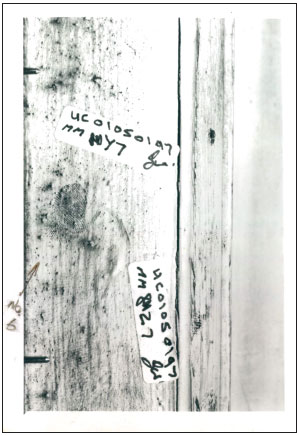
Figure 3
1.39. Y7 featured in the prosecutions in both HMA v Asbury and HMA v McKie. The Inquiry had the productions that were prepared by SCRO fingerprint examiners for the trials which included enlargements prepared by them to illustrate their conclusion (Productions 152,55 18056 and 18957 ).
The cluster of marks QI2
1.40. QI2, a cluster of marks, was found on a small metal tin containing money. The tin had been seized from the home of David Asbury. Part of QI2 was identified as the right forefinger of Miss Ross and part as the right middle finger of Mr Asbury. During the Inquiry the parts of the marks came to be referred to as 'QI2 Ross' and 'QI2 Asbury'.
1.41. The tin, which is house-shaped and overprinted with a multicoloured design, is approximately 12.5 cm long x 8 cm wide x 7.3 cm high. As can be seen from the photograph at figure 4,58 the cluster QI2 was found on an end which featured a scene with a horse drawn tram. QI2 was at the top left of the picture of the tram and some of the underlying detailing of the tram (including the steps, the handrail and the facia) comes through in the mark. The mark is shown, actual size, in figure 5.59
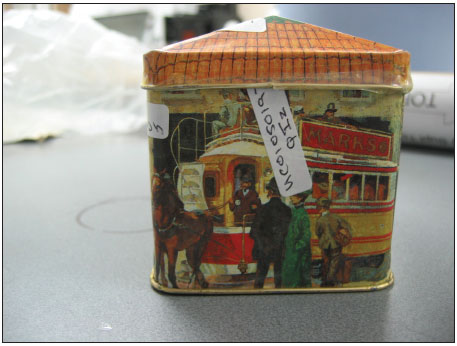
Figure 4
1.42. Marks QI2 Ross and QI2 Asbury featured in the evidence in the trial of Mr Asbury but not in the trial of Ms McKie.
QI2 Ross
1.43. Prints were taken twice from Miss Ross's body at the mortuary, on 1060 and 23 January 1997,61 and the Inquiry had the two original sets. It was the print form dated 10 January 1997 that was used by the SCRO examiners who initially identified QI2 Ross.
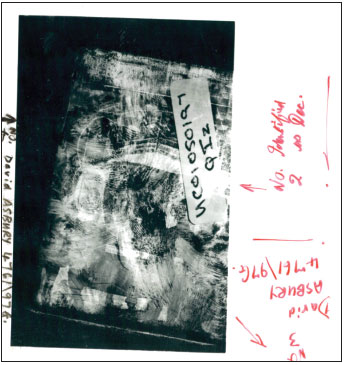
Figure 5
1.44. The Inquiry had the original of the image of QI2 studied by them62 and the negative of that image. Reproductions were obtained from the negative and, in addition, the Metropolitan Police provided the Inquiry with high resolution scanned copies of the original image.
1.45. QI2 Ross was the subject of a joint report by the SCRO examiners Mr Hugh MacPherson, Mr Charles Stewart, Ms Fiona McBride and Mr Anthony McKenna that was Production 10163 in HMA v Asbury. Part of the mark was certified as that of Miss Ross under reference to the 16 points in the charted enlargement in Production 99. The Inquiry recovered only relatively poor photocopies of Production 99.64
XF, QI2 Asbury and various other Q marks
1.46. XF, QI2 Asbury, QD2, QE2 and QL2 were marks identified as having been made by Mr Asbury. They were all included in the same joint report in HMA v Asbury65 and the Inquiry had the original of the accompanying Production 9866 which contained photographic images of the marks and a charted enlargement for XF but not for the other marks.
1.47. The Inquiry recovered only what appeared to be colour photocopies of the fingerprints of Mr Asbury, not the inked originals. These were three charge/arrest forms all dated 26 January 1997.67
1.48. XF was identified as the right forefinger of Mr Asbury. It is shown in figure 6.68 The Inquiry had the original image of XF used by SCRO when the mark was first identified,69 and the corresponding negative, from which paper and digital copies were reproduced for use by the Inquiry.
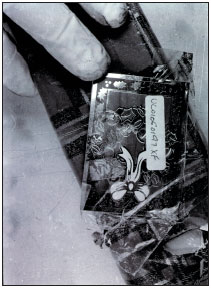
Figure 6
1.49. QI2 Asbury. The QI2 cluster is described above. As regards the part attributed to Mr Asbury, the Inquiry had the original of the image studied by the SCRO examiners who initially identified the print, the same photograph as was used in the identification of QI2 Ross.70 During the Inquiry Ms McBride outlined, on an enlargement, the part of the mark attributed to Mr Asbury71 and this is shown in figure 7. The Inquiry had a second original image of QI272 and also had the negatives of those images.
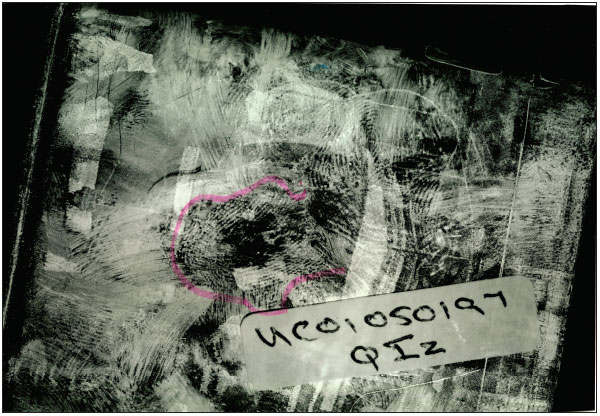
Figure 7
1.50. QD2 was identified as the right little finger of Mr Asbury. The banknote on which it was found no longer exists.73 The Inquiry had only photocopies of the original image that the SCRO examiners used in their comparison and on which they wrote their findings in manuscript. The Inquiry had the different photographic original of mark QD2 contained in Production 98 and the negatives of that image, from which copies were reproduced.
1.51. QE2 and QL2, along with QI2, were among a batch of eight marks (QE2-QL2) found on the tin. QE2 was on the lid and QL2 on the base. The Inquiry had the original photographs of both QE274 and QL275 that the SCRO examiners examined on which they wrote their findings in manuscript. The Inquiry also had the images of those marks that were included in Production 98.76
Footnotes
1. A note about the investigation and prosecution of crime in Scotland is at Appendix 7.
2. CO_0215 HMA v Asbury - police observer's report
3. Now Lord Wallace of Tankerness
4. Scottish Parliament Official Report 22 June 2000 Col 681
5. Now Lord Boyd of Duncansby
6. Now Sheriff Gilchrist
7. Scottish Criminal Record Office - The Fingerprint Bureau Primary Inspection 2000, a report by Her Majesty's Inspectorate of Constabulary, published on 14 September 2000. This was a report on the fingerprint bureau only - SG_0375. The next HMICS report was on the entire SCRO.
8. SG_0522
9. SCRO 2000 Primary Inspection, published on 24 May 2001, URL: http://www.scotland.gov.uk/hmic/docs/scro2rev00-00.asp Follow-up reports: HMICS Second Year Review of SCRO 2000 Primary Inspection, published on 13 December 2001 - SG_0842; HMICS Third Year Review of SCRO 2000, published on 22 May 2003, URL: http://www.scotland.gov.uk/Topics/Justice/public-safety/Police/local/15403/publications/7442-1 (a review of both the 2000 report on the bureau and the 2000 Primary Inspection).
10. Lord Emslie: http://www.scotcourts.gov.uk/opinions/A3254_00.html Feb 02
11. SP_0004
12. Extra Division of the Inner House of the Court of Session: http://www.scotcourts.gov.uk/opinions/A3254.html Feb 03
13. SG_0014 pdf pages 5-6
14. Lord Wheatley: http://www.scotcourts.gov.uk/opinions/A4960.html Dec 03
15. Scottish Criminal Record Office Primary Inspection 2004, a report by Her Majesty's Inspector of Constabulary published on 17 March 2005, URL: http://www.scotland.gov.uk/Publications/2005/03/20826/54258. Follow-up report (Eighteen Month Review Inspection): Her Majesty's Inspector of Constabulary (2006) SCRO Review Inspection 2006 published on 15 December 2006, URL: http://www.scotland.gov.uk/Publications/2006/12/07094448/0
16. Lord Hodge: http://www.scotcourts.gov.uk/opinions/2006CSOH54.html Mar 06
17. Scottish Parliament Official Report 9 February 2006 Col 23240. Scottish Parliament Justice 1 Committee 3rd Report, 2007 (Session 2) Inquiry into the Scottish Criminal Record Office and the Scottish Fingerprint Service, SP Paper 743 Edinburgh RR Donnelly, 2007, paras 12-14
18. Also, on 3 May 2006, an excerpt from the report and two accompanying documents were published on the BBC website.
19. Scottish Parliament Official Report 8 March 2006 Col 23783. Scottish Parliament Justice 1 Committee 3rd Report, 2007 (Session 2) Inquiry into the Scottish Criminal Record Office and the Scottish Fingerprint Service, para 18.
20. Police, Public Order and Criminal Justice (Scotland) Act 2006, asp 10, HMSO, 2006
21. Scottish Parliament Justice 1 Committee 3rd Report, 2007 (Session 2) Inquiry into the Scottish Criminal Record Office and the Scottish Fingerprint Service; Justice 1 Committee news release on report into the Scottish Criminal Record Office and the Scottish Fingerprint Service 15 February 2007, URL: http://www.scottish.parliament.uk/nmCentre/news/news-comm-07/cj107-002.htm
22. Scottish Government 2007 Reporting on 100 Days: Moving Scotland Forward, URL: http://www.scotland.gov.uk/Publications/2007/08/23162100/2
23. Scottish Parliament Written Answer 14 March 2008 (S3W-10920) URL: http://thefingerprintinquiryscotland.org.uk/inquiry/76.48.html
24. FI_0130 pdf page 15 Mr Wertheim Phase 1 Comparative Exercise and FI_0118 Inquiry Statement of Mr Wertheim. See chapter 27
25. PS_0002h and PS_0001h
26. FI_0031 para 110 Inquiry Witness Statement of Mr Geddes and DB_0003
27. MP_0012
28. 1.52m
29. It was roughly in the position indicated by the blue arrow in the image FI_0910.03.
30. CO_0345 pdf page189 (images of the mark are on pdf page 188). (One of the images from page 189 is shown alongside a close-up of the mark in FI_2710.04.)
31. FI_2432 - 'axonometric views'
32. EA_0069 pdf page 21 - Report of Dr Bleay dated 4 March 2009
33. PS_0002h
34. EA_0067.006 from EA_0067 pdf page 6
35. Mr Grigg 29 September pages 27-28. The NPIA was formerly known as the National Training Centre for Scientific Support to Crime Investigation.
36. EA_0164.001 from EA_0164 pdf page 1
37. EA_0164 and Dr Bleay 16 November pages 148-150
38. EA_0164.005 from EA_0164 pdf page 5
39. AZ_0022 para 10.1
40. CO_0063 pdf page 2
41. e.g. TS_0006
42. e.g. DB_0172h
43. Now the NPIA
44. e.g. EA_0067.006; he also produced images from an original negative e.g. EA_0035
45. EA_0067 pdf page 5. The presence of this striation is discussed in Chapter 11 para 42ff.
46. ST_0004h
47. DB_0008h
48. DB_0009h
49. DB_0034
50. DB_0140h
51. TS_0010
52. TS_0009
53. PS_0002h
54. ST_0004h
55. ST_0006h
56. DB_0011h
57. DB_0012h
58. EA_0067.007 from EA_0067 pdf page 7
59. DB_0001h
60. DB_0142h
61. DB_0017h
62. DB_0001h
63. SG_0377
64. CO_0207h and SG_0131h
65. SG_0352
66. SG_0010h
67. SG_0349h (marked "inaccurate"), SG_0350h and SG_0351h
68. EA_0188
69. CO_1987h
70. DB_0001h
71. FI_2463
72. CO_1993h
73. EA_0067 pdf page 9
74. CO_1991h
75. CO_1992h
76. SG_0010h
Check these out
- Best Non Gamstop Casinos UK 2025
- Betting Sites Not On Gamstop
- UK Casino Not On Gamstop
- Gambling Sites Not On Gamstop
- Sites Not On Gamstop
- Casinos Not On Gamstop
- Casinos Not On Gamstop
- Non Gamstop Casino
- Non Gamstop Casinos
- Non Gamstop Casinos
- UK Online Casinos Not On Gamstop
- UK Casinos Not On Gamstop
- Best Betting Sites
- Casino Sites Not On Gamstop
- UK Casinos Not On Gamstop
- UK Online Casinos Not On Gamstop
- Non Gamstop Casinos UK
- Casino Sites UK Not On Gamstop
- Non Gamstop Casino UK
- Casinos Not On Gamstop
- Non Gamstop Casinos
- Slots Not On Gamstop